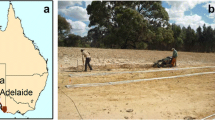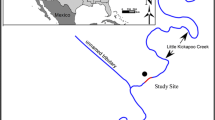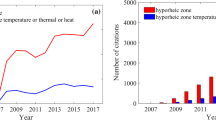Abstract
Two methods applying natural heat as a tracer to quantify surface water–groundwater exchange were evaluated using field data. Arrays capable of monitoring and recording the streambed response to diurnal temperature variations in the surface water were deployed for a 2-month period in three locations in perennial pools at Maules Creek, New South Wales, Australia. Multi-level array design, field deployment and parameter estimation are discussed. The applicability of analytical solutions derived from the heat transport equation to the streambed environments was analysed using the recorded temperature time series. The stream was found to lose water to the aquifer, which was supported by simultaneously recorded hydraulic gradients. However, the one-dimensional (1D) analytical solutions did not adequately describe the observed streambed thermal response at two locations. The resulting artefacts in the estimated flow velocities are discussed. It was hypothesised that the artefacts originate from model limitation due to streambed heterogeneity and application of 1D solutions to multi-dimensional and dynamic streambed flow. This consequently imposes limitations on the field applicability of the methods. Nevertheless, in combination with time series of surface water and streambed water levels, the use of heat as a tracer provided a powerful tool for better understanding the shallow hydrogeological system.
Résumé
Deux méthodes utilisant la chaleur naturelle comme marqueur pour quantifier un échange eau de surface-eau de nappe ont été mises en œuvre utilisant des données de terrain. Des dispositifs capables de suivre et d’enregistrer dans le lit mineur la réponse de l’eau de surface aux variations de température diurne ont été mis en place pendant une période de 2 mois en trois emplacements sur biefs pérennes à Maules Creek, Nouvelle Galle du Sud, Australie. L’architecture du dispositif, la répartition spatiale et l’adéquation des paramètres sont discutés. La validité des solutions analytiques de l’équation d’échange de chaleur avec l’environnement du lit mineur a été étudiée en utilisant les chroniques de température enregistrées. On a montré que le cours d’eau se décharge dans l’aquifère, ce qui est en conformité avec les gradients hydrauliques enregistrés simultanément. Toutefois, les solutions analytiques à une dimension (1D) n’ont pas décrit de façon satisfaisante la réponse thermique du lit mineur en deux emplacements. Les anomalies résultantes dans le flux estimé sont discutées. On suppose que les anomalies résultent d’une limitation du modèle due à l’hétérogénéité du lit mineur et à l’application de solutions 1 D pour modéliser un flux dans un espace multi-dimensionnel. Ceci limite par suite l’application des méthode sur le terrain. Cependant, avec les chroniques températures de surface-niveaux du lit mineur, l’utilisation de la chaleur comme traceur constitue un outil puissant pour mieux comprendre le système hydrogéologique superficiel.
Resumen
Se evaluaron dos métodos que utilizan el calor natural como un trazador para cuantificar el intercambio aguas superficial – agua subterránea usando datos de campo. Se implementaron dispositivos capaces de monitorear y registrar la respuesta del lecho del río a variaciones diurnas de las temperaturas en la superficie del agua para un período de 2 meses en tres sitios en los cuerpos de agua perennes en el arroyo Maules, Nueva Gales del Sur, Australia. Se discuten el diseño del dispositivo multi – nivel, la implementación de campo y la estimación de los parámetros. Se analiza la aplicabilidad de soluciones analíticas desarrolladas a partir de la ecuación de transporte de calor a los ambientes del lecho del río usando las series temporales registrada de las temperaturas. Se encontró que la corriente pierde agua hacia acuífero, lo cual fue confirmado por los gradientes hidráulicos registrados simultáneamente. Sin embargo, las soluciones analíticas unidimensional (1D) no describieron adecuadamente la respuesta térmica del lecho del río observada en dos sitios. Se discuten los productos resultantes de la estimación de las velocidades de flujo. Se formuló la hipótesis que los productos se originaban a partir de las limitaciones del modelo debido a la heterogeneidad del lecho del río y la aplicación de soluciones 1D al flujo dinámico y multidimensional en el lecho del río. Esto consecuentemente impone limitaciones en la aplicabilidad a los métodos de campo. Sin embargo, la combinación del uso de calor como un trazador con las series temporales de los niveles de aguas superficiales y del lecho del río, proporciona una herramienta poderosa para entender mejor el sistema hidrogeológico somero.
摘要
用野外数据评价了两个以天然热作为示踪剂来量化地表水-地下水交换量的方法。将可监测和记录河床对地表水日温度变化响应的阵列布置在澳大利亚新南威尔士州Maules Creek的三个常年有水的水池里, 测试期2个月。对多水平阵列设计、野外布置和参数估计进行了讨论。通过记录的温度时间序列, 分析了基于热传导方程的解析解对河床环境的适用性。研究发现, 溪水有一部分下渗到含水层中, 这为同时记录的水力梯度证实。然而在两个研究区, 一维解析解并不能适当地描述观测到的河床热响应。还讨论了估计的水流速度下产生的假象。认为这种假象的发生源于将模型用于河床具不均一性和把一维解法应用于多维及动力流情形时所产生的局限性。这导致了这种方法在野外应用上的局限性。不过, 当与地表水和河床水位时间序列联合应用时, 把热作为一种示踪剂为更好的理解浅部水文地质系统提供了非常有用的工具。
Resumo
Foram avaliados dois métodos de aplicação de calor natural como marcador para quantificar a troca de águas de superfície/águas subterrâneas usando dados de campo. Foram utilizados instrumentos com capacidade de monitorizar e registar a resposta do leito às variações de temperatura diurna na água de superfície. Esses instrumentos foram implantados, durante um período de 2 meses, em três locais, em pegos perenes no Ribeiro de Maules, Nova Gales do Sul, Austrália. São discutidos o esquema de configuração multi-nível, a implantação de campo e a estimação de parâmetros. A aplicabilidade das soluções analíticas derivadas da equação de transporte de calor para os ambientes de leito foi analisada, utilizando séries temporais de registo de temperatura. Detectou-se que a linha de água perdia água para o aquífero, facto que foi apoiado pelo registo simultâneo de gradientes hidráulicos. No entanto, as soluções analíticas unidimensionais (1D) não descrevem adequadamente a resposta térmica do leito observada em dois locais. São discutidos os resultados erróneos na estimação das velocidades de fluxo. Foi colocada a hipótese dos erros serem originados pela limitação do modelo, devido à heterogeneidade do leito do ribeiro e à aplicação de soluções unidimensionais (1D) a fluxos multi-dimensionais e dinâmicos de leito de rio. Em consequência, este facto leva à imposição de limitações sobre a aplicabilidade dos métodos. No entanto, em combinação com a série histórica das águas superficiais e os níveis de água do leito do rio, o uso do calor como um traçador proporcionou uma poderosa ferramenta para a melhor compreensão do sistema hidrogeológico pouco profundo.











Similar content being viewed by others
References
Alexander MD, Caissie D (2003) Variability and comparison of hyporheic water temperatures and seepage fluxes in a small Atlantic salmon stream. Ground Water 41:72–82. doi:10.1111/j.1745-6584.2003.tb02570.x
Andersen, MS, Acworth, RI (2007) Hydrochemical investigations of surface water groundwater interactions in a sub-catchment in the Namoi Valley, NSW, Australia. In: Ribeiro L, Chambel A, Condesso de Melo MT (eds) Groundwater and Ecosystems Proceedings of the XXXV IAH Congress. Lisbon, 17–21 September 2007
Andersen MS, Acworth RI (2009) Stream-aquifer interactions in the Maules Creek catchment, Namoi Valley, New South Wales, Australia. Hydrogeol J 17:2005–2021. doi:10.1007/s10040-009-0500-9
Anderson MP (2005) Heat as a ground water tracer. Ground Water 43:951–968. doi:10.1111/j.1745-6584.2005.00052.x
Arrigoni AS, Poole GC, Mertes LAK, O'Daniel SJ, Woessner WW, Thomas SA (2008) Buffered, lagged, or cooled? Disentangling hyporheic influences on temperature cycles in stream channels. Water Resour Res 44, W09418. doi:10.1029/2007WR006480
Baskaran S, Brodie RS, Ransley T, Baker P (2009) Time-series measurements of stream and sediment temperature for understanding river-groundwater interactions: Border Rivers and lower Richmond catchments, Australia. Aust J Earth Sci 56:21–30. doi:10.1080/08120090802541903
Bear J (1988) Dynamics of fluids in porous media: environmental science series. Elsevier, New York
Becker MW, Georgian T, Ambrose H, Siniscalchi J, Fredrick K (2004) Estimating flow and flux of ground water discharge using water temperature and velocity. J Hydrol 296:221–233. doi:10.1016/j.jhydrol.2004.03.025
Blasch KW, Constantz J, Stonestrom DA (2007) Thermal methods for investigating ground-water Recharge (Appendix) US Geol Surv Prof Pap 1703
Bredehoeft JD, Papadopulos IS (1965) Rates of vertical groundwater movement estimated from Earths thermal profile. Water Resour Res 1:325
Brunke M, Gonser T (1997) The ecological significance of exchange processes between rivers and groundwater. Freshw Biol 37:1–33
Cardenas MB, Wilson JL (2007) Effects of current-bed form induced fluid flow on the thermal regime of sediments. Water Resour Res 43, W08431. doi:10.1029/2006WR005343
Carslaw HS, Jaeger JC (1959) Conduction of Heat in Solids. Clarendon, Oxford
Chen XH, Shu LC (2002) Stream-aquifer interactions: evaluation of depletion volume and residual effects from ground water pumping. Ground Water 40:284–290. doi:10.1111/j.1745-6584.2002.tb02656.x
Conant B (2004) Delineating and quantifying ground water discharge zones using streambed temperatures. Ground Water 42:243–257. doi:10.1111/j.1745-6584.2004.tb02671.x
Constantz J (2008) Heat as a tracer to determine streambed water exchanges. Water Resour Res 44, W00D10. doi:10.1029/2008WR006996
Constantz J, Stonestrom DA (2003) Heat as a tool for studying the movement of ground water near streams. US Geol Surv Circ 1260
Constantz J, Thomas CL, Zellweger G (1994) Influence of diurnal-variations in stream temperature on streamflow loss and groundwater recharge. Water Resour Res 30:3253–3264. doi:10.1029/94WR01968
Constantz J, Stonestrom D, Stewart AE, Niswonger R, Smith TR (2001) Analysis of streambed temperatures in ephemeral channels to determine streamflow frequency and duration. Water Resour Res 37:317–328. doi:10.1029/2000WR900271
Constantz J, Stewart AE, Niswonger R, Sarma L (2002) Analysis of temperature profiles for investigating stream losses beneath ephemeral channels. Water Resour Res 38:1316. doi:10.1029/2001WR001221
Constantz J, Cox MH, Su GW (2003) Comparison of heat and bromide as ground water tracers near streams. Ground Water 41:647–656. doi:10.1111/j.1745-6584.2003.tb02403.x
Dahm CN, Grimm NB, Marmonier P, Valett HM, Vervier P (1998) Nutrient dynamics at the interface between surface waters and groundwaters. Freshw Biol 40:427–451. doi:10.1046/j.1365-2427.1998.00367.x
Essaid HI, Zamora CM, McCarthy KA, Vogel JR, Wilson JT (2008) Using heat to characterize streambed water flux variability in four stream reaches. J Environ Qual 37:1010–1023. doi:10.2134/jeq2006.0448
Evans EC, Petts GE (1997) Hyporheic temperature patterns within riffles. Hydrol Sci 42:199–213
Fanelli RM, Lautz LK (2008) Patterns of water, heat, and solute flux through streambeds around small dams. Ground Water 46:671–687. doi:10.1111/j.1745-6584.2008.00461.x
Harris FJ (1978) Use of Windows for harmonic-analysis with discrete Fourier-transform. Proc IEEE 66:51–83. doi:10.1109/PROC.1978.10837
Hatch CE, Fisher AT, Revenaugh JS, Constantz J, Ruehl C (2006) Quantifying surface water-groundwater interactions using time series analysis of streambed thermal records: method development. Water Resour Res 42, W10410. doi:10.1029/2005WR004787
Holzbecher E (2005) Inversion of temperature time series from near-surface porous sediments. J Geophys Eng 2:343–348. doi:10.1088/1742-2132/2/4/S07
Johnson AN, Boer BR, Woessner WW, Stanford JA, Poole GC, Thomas SA, O'Daniel SJ (2005) Evaluation of an inexpensive small-diameter temperature logger for documenting ground water-river interactions. Ground Water Monit Remediat 25:68–74. doi:10.1111/j.1745-6592.2005.00049.x
Kalbus E, Reinstorf F, Schirmer M (2006) Measuring methods for groundwater– surface water interactions: a review. Hydrol Earth Syst Sci 10:873–887
Keery J, Binley A, Crook N, Smith JWN (2007) Temporal and spatial variability of groundwater-surface water fluxes: development and application of an analytical method using temperature time series. J Hydrol 336:1–16. doi:10.1016/j.jhydrol.2006.12.003
Lautz LK (2010) Impacts of non-ideal field conditions on vertical water velocity estimates from streambed temperature time series. Water Resour Res 46, W01509. doi:10.1029/2009WR007917
Lowry CS, Walker JF, Hunt RJ, Anderson MP (2007) Identifying spatial variability of groundwater discharge in a wetland stream using a distributed temperature sensor. Water Resour Res 43, W10408. doi:10.1029/2007WR006145
Muskat M (1937) The flow of fluids through porous media. J Appl Phys 8:274–282. doi:10.1063/1.1710292
Neuman SP (1990) Universal scaling of hydraulic conductivities and dispersivities in geologic media. Water Resour Res 26:1749–1758. doi:10.1029/WR026i008p01749
NIST (2009) Thermophysical properties of fluid systems. National Institute of Standards and Technology, Boulder, CO. http://webbook.nist.gov/chemistry/fluid/. Cited February 2010
Ronan AD, Prudic DE, Thodal CE, Constantz J (1998) Field study and simulation of diurnal temperature effects on infiltration and variably saturated flow beneath an ephemeral stream. Water Resour Res 34:2137–2153. doi:10.1029/98WR01572
Schmidt C, Bayer-Raich M, Schirmer M (2006) Characterization of spatial heterogeneity of groundwater-stream water interactions using multiple depth streambed temperature measurements at the reach scale. Hydrol Earth Syst Sci 10:849–859
Schmidt C, Conant B, Bayer-Raich M, Schirmer M (2007) Evaluation and field-scale application of an analytical method to quantify groundwater discharge using mapped streambed temperatures. J Hydrol 347:292–307. doi:10.1016/j.jhydrol.2007.08.022
Schön JH (1996) Physical properties of rocks: fundamentals and principles of petrophysics—handbook of geophysical exploration, Pergamon, New York
Selker J, van de Giesen N, Westhoff M, Luxemburg W, Parlange MB (2006a) Fiber optics opens window on stream dynamics. Geophys Res Lett 33, L24401. doi:10.1029/2006GL027979
Selker JS, Thevenaz L, Huwald H, Mallet A, Luxemburg W, de Giesen NV, Stejskal M, Zeman J, Westhoff M, Parlange MB (2006b) Distributed fiber-optic temperature sensing for hydrologic systems. Water Resour Res 42, W12202. doi:10.1029/2006WR005326
Silliman SE, Booth DF (1993) Analysis of time-series measurements of sediment temperature for identification of gaining vs. losing portions of Juday-Creek, Indiana. J Hydrol 146:131–148. doi:10.1016/0022-1694(93)90273-C
Silliman SE, Ramirez J, McCabe RL (1995) Quantifying downflow through creek sediments using temperature time-series: one-dimensional solution incorporating measured surface-temperature. J Hydrol 167:99–119. doi:10.1016/0022-1694(94)02613-G
Song JX, Chen XH, Cheng C, Summerside S, Wen FJ (2007) Effects of hyporheic processes on streambed vertical hydraulic conductivity in three rivers of Nebraska. Geophys Res Lett 34, L07409. doi:10.1029/2007GL029254
Sophocleous M (2002) Interactions between groundwater and surface water: the state of the science. Hydrogeol J 10:52–67. doi:10.1007/s10040-001-0170-8
Stallman RW (1965) Steady 1-dimensional fluid flow in a semi-infinite porous medium with sinusoidal surface temperature. J Geophys Res 70:2821–2827
Suzuki S (1960) Percolation measurements based on heat flow through soil with special reference to paddy fields. J Geophys Res 65:2883–2885
Webb BW, Hannah DM, Moore RD, Brown LE, Nobilis F (2008) Recent advances in stream and river temperature research. Hydrol Process 22:902–918. doi:10.1002/hyp.6994
Weeks EP (2006) R.W. Stallman (1924–1977): an underappreciated contributor to hydrogeology. Ground Water 44:618-621. doi:10.1111/j.1745-6584.2006.00218.x
Winter TC, Harvey JW, Franke OL, Alley WM (1998) Ground water and surface water: a single resource. US Geol Surv Circ 1139
Woessner WW (2000) Stream and fluvial plain ground water interactions: rescaling hydrogeologic thought. Ground Water 38:423–429. doi:10.1111/j.1745-6584.2000.tb00228.x
Woodside W, Messmer JH (1961) Thermal conductivity of porous media.1. Unconsolidated sands. J Appl Physi 32:1688. doi:10.1063/1.1728419
Acknowledgements
We gratefully acknowledge the funding by the Cotton Research Community CRC (Project No. 2.02.03). We would also like to thank the Australian Department of Water and Energy (DWE) for allowing us access to their system of monitoring wells. Also we thank B. Morris and M. Harley for assistance with the DGPS equipment, K. Crawford for sharing his knowledge about the study area, and S. Crawford for providing accommodation and meals while in the field. We would like to express our sincere appreciation to C. Hatch and an anonymous reviewer for helping us to improve the manuscript.
Author information
Authors and Affiliations
Corresponding author
Rights and permissions
About this article
Cite this article
Rau, G.C., Andersen, M.S., McCallum, A.M. et al. Analytical methods that use natural heat as a tracer to quantify surface water–groundwater exchange, evaluated using field temperature records. Hydrogeol J 18, 1093–1110 (2010). https://doi.org/10.1007/s10040-010-0586-0
Received:
Accepted:
Published:
Issue Date:
DOI: https://doi.org/10.1007/s10040-010-0586-0




